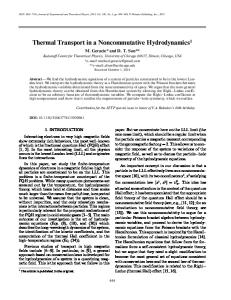Statistical Phonon Transport Model of Thermal Transport in Silicon
- PDF / 286,657 Bytes
- 6 Pages / 612 x 792 pts (letter) Page_size
- 91 Downloads / 325 Views
1229-LL09-09
Statistical Phonon Transport Model of Thermal Transport in Silicon Thomas W. Brown III and Dr. Edward Hensel Mechanical Engineering, Rochester Institute of Technology, Rochester, NY, 14623, U.S.A. ABSTRACT Thermal transport in crystalline materials at various length scales can be modeled by the Boltzmann transport equation (BTE). A statistical phonon transport (SPT) model is presented that solves the BTE in a statistical framework that incorporates a unique state-based phonon transport methodology. Anisotropy of the first Brillouin zone (BZ) is captured by utilizing directionally-dependent dispersion curves obtained from lattice dynamics calculations. A rigorous implementation of phonon energy and pseudo-momentum conservation is implemented in the ballistic thermal transport regime for a homogeneous silicon nanowire with adiabatic specular boundary conditions. INTRODUCTION When a structure has a characteristic length considerably smaller than the phonon mean free path, scattering at interfaces and boundaries dominate, making macroscale theory ineffective at predicting thermal transport. Several techniques have been used to model thermal transport at various length scales. These techniques include the BTE [1,2], the finite volume method [3], molecular dynamics [4,5,6,7], and the Monte Carlo (MC) method [8,9,10]. The advantages and drawbacks of each method have been reviewed previously [3,11,12,13,14]. The MC technique treats phonons as particles with properties such as wave vector, polarization, frequency, and position which must be individually tracked. Phonons are allowed to drift and scatter in time as described by the BTE. Since the number of phonons that must be stored is extremely large, many approximations to reduce MC computational time have been made. These include the use of scaling factors, approximations related to the polarization and dispersion behavior of phonons and the representation of phonon-phonon scattering. The current SPT model addresses several fundamental issues that currently limit the MC technique, while retaining the fundamental probabilistic view of phonon transport common to MC models. The SPT model incorporates the physics of phonon transport whenever possible, and paves the way for further advancement in thermal transport modeling at various length scales. STATISTICAL PHONON TRANSPORT (SPT) MODEL THEORY The transport of a population of phonons can be described using the BTE as 𝑑𝑓 𝑑𝑓 + 𝑽𝑔 ∙ 𝛻𝑓 = , 𝑑𝑡 𝑑𝑡 𝑠𝑐𝑎𝑡𝑡𝑒𝑟
(1)
where f(t,r,K) is the distribution function of an ensemble of phonons, Vg is the phonon group velocity, r is the position vector of an individual stochastic particle, K is the wave vector, and t is
time [8]. The left hand side of Equation (1) represents the drift term of the phonon ensemble away from equilibrium. The right hand side of Equation (1) is the scattering term that restores the phonon population to equilibrium. The scattering term includes the following scattering processes: phonon-phonon, phonon-impurity, phonon-isotope, imperfections, grain boun
Data Loading...








